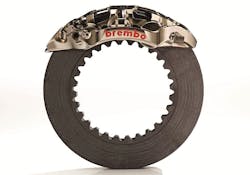In Formula One since 1975, Brembo claims leader status yet again in 2013 as supplier of braking systems to five teams: Infiniti Red Bull Racing, Mercedes AMG Petronas F1 Team, Sauber F1 Team, Scuderia Ferrari and Scuderia Toro Rosso, all of which have relied on the Italian company for many years to optimize the braking performances of their single-seater.
From the regulations point of view, the 2013 Formula One season does not present significant changes compared to 2012, in view of the important technical developments expected in 2014, when the Italian company will be ready for a new technological challenge. The main technical innovation for 2013 season concerns the evolution of tires, which are 2 kg heavier and have softer compounds, with consequent greater wear, thereby reaching optimal exercise temperature faster, an increase in the number of pit stops, and more overtaking opportunities. Therefore, it will be even more important to manage the car during braking to avoid the damage caused by locking the wheels up and limit wear for tires. Having a braking system that ensures efficient modulation can be essential from this point of view and Brembo’s friction material has this feature as one of its basic qualities.
Greater ventilation for new brake discs
In recent years Brembo engineers completely changed the cooling of brakes, which in Formula One can reach the maximum temperature of 1.200 °C, by adapting the cooling system, which now features up to 1,000 ventilation holes. The ventilation of Brembo carbon brake discs went through a development process, considerably increasing overall performances of braking system. In 2008 Brembo introduced a “spline” fastener between disc and cup; that is, the insertion of a titanium element linking braking ring to hub. In previous years ventilation was highly restricted by the block caused by the fasteners of the braking ring. But with the introduction of a “spline” - a sort of helical-toothed wheels - the inner part of disc opened at airflow.
The increase of airflow was also achieved through CFD calculations (Computational Fluid Dynamics, fluid dynamics study through computer), a synergic study, developed by each race team, of the air flow between the intake and the brake disc. This resulted in an optimal design of ventilation holes, which increased in number but reduced in diameter, thereby increasing exponentially the carbon surface open to airflow and therefore thermic discharge. It’s possible to further summarize this evolution, with a simple numerical comparison. Before 2008 the design featured 30 holes, in 2011 it increased to 200 holes, and today some of the Brembo teams use discs with more than 1,000 holes.
This structural evolution required a much more complex mechanical processing, along with a growing effort in terms of in-depth analysis of fluid dynamics. The support of each team has been crucial to the design of air intakes for new cars.
Lower wear of brake system thanks to new CER and customization of systems
Material is considerably changed as well. New CER represents an evolution of CCR material that considerably reduces wear, guaranteeing more effective thermic conductivity. Compared to previous material, CER offers excellent warm-up time, that is, maximum rapidity in reaching more efficient operating temperatures; a wide application range in terms of both pressure and temperature; and very smooth friction performance. All these features provide the driver with a perfect modulation of the braking system. The incredibly low wear results in more reliable performance from the start to the end of race.
Disc material is the same for all teams supplied by Brembo, who continues to research and develop materials that are more manageable. Formula One demands an extensive customization of brake systems, deriving from the different solutions adopted by F1 car designers. The five teams supplied by Brembo require a brake system that is increasingly “tailor-made”, closely integrated with the design of the car and certain to undergo continual development during the course of the season. The factors involved in customization of a system are its rigidity, signifying the most advantageous compromise between the various parts making up the corner assembly — wheel, hub carrier, disc and brake caliper — and control of the airflow within the wheel, which is a factor in determining the number of aerodynamic load points.
Significant numbers
In a full season, Brembo supplies each team with the following material for its 2 cars:
· 10 sets of calipers (i.e. 4 x 10 components)
· From 140 to 240 discs
· From 280 to 480 pads
Some ten hours of continuous manufacturing activity are required to produce a caliper, although in reality the process is interrupted by other steps including various surface treatments, hand assembly and subsequent testing. Both the materials and the steps of the entire process are always 100% tested.
New graphic design and content for www.formula1.brembo.com mini web site
In conjunction with the start of the 2013 World Championship, the Italian company’s web site dedicated to the Formula One World Championship will introduce new content and an innovative graphic design. In addition to technical data concerning braking points of each circuit, www.formula1.brembo.com will provide enthusiasts with countless information about the world of braking systems for Formula One cars.
Besides Formula One data, Brembo has created a section dedicated entirely to MotoGP and beginning this year there will also be available information and data about the IZOD IndyCar Championship, the American series in which Brembo is the exclusive supplier.
Latest in Retail
Latest in Retail



